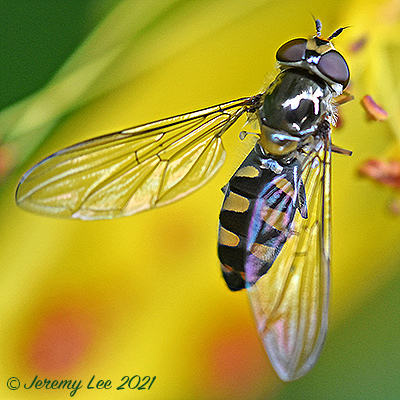
 |
|
Scientific Classifications explained » Amphibians » Ants » Aphids » Bees » Beetles » Birds » Bugs » Butterflies » Caterpillars » Damselflies » Dragonflies » Earwigs » Flies » Frog/Leafhoppers » Fungi » Galls » Grasshoppers » Harvestmen » Hoverflies » Lacewings » Ladybirds » Leaf Mines » Lichens » Mammals » Millipedes » Mosses » Moths » Sawflies » Slugs » Snails » Spiders » Trees & Shrubs » Wasps » Wild Flowers » Woodlice » Postboxes |
UK Nature > Hoverflies > Meliscaeva auricollis

Scientific Name: Meliscaeva auricollis Common Name: N/A Meliscaeva auricollis is a widespread species that is fairly common throughout Britain, though prone to fluctuating numbers that suggest the British population may be boosted by immigration in some years. Though small and dark coloured, the slanting rear border of the yellow crescent marks on tergite 2, particularly in males, help to identify the species. The spring generation tend to be darker bodied than those born later in the year. The aphidophagous larvae have been recorded on a variety of herbs, shrubs and trees. Adults can be recorded in all months, typically visiting spring blossoms such as sallow and Prunus species and Lesser Celandine in March and April, umbellifers and bramble in summer, and Ivy in autumn. Prefers well-wooded places and is usually found around trees. Can be seen from February to December. This is one of the first hoverflies to appear in the year. A warm day, even in January or February, can bring it out of hibernation. |
|

https://www.uknature.co.uk is a website dedicated to showing the immense diversity of UK nature and wildlife. Our vast range of habitats, from lowland arable to snow covered mountains, from storm-ravaged coastlines to peaceful inland freshwater lakes and rivers, from dry, sandy heaths to deciduous and coniferous forests, all these habitats contribute to the abundance of UK nature. We have wild birds in huge numbers either residing or visiting our shores (597 recorded species as at July 2013) and we must also not forget the humble back garden with its grass lawns, flower beds filled with nectar rich flowers, shrubs and trees, all designed to attract huge numbers of insects such as bees, moths, butterflies and hoverflies; and finally the small ponds which provide safe havens for frogs, toads, newts and even slow worms and grass snakes. www.uknature.co.uk is the showcase for my personal passion, photographing uknature in all its glory. I sincerely hope you all enjoy the fruits of my labours. This site and all images contained therein is © Jeremy Lee 2004 - 2025. All Rights Reserved. Site design by Jeremy Lee. Site development & IT Support by Stuart Lee. |